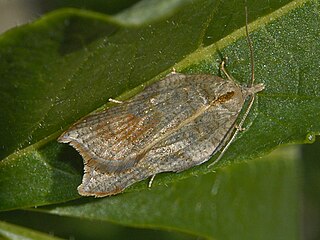
Acleris emargana, the notched-winged tortricid, is a moth of the family Tortricidae. The species was first described by Johan Christian Fabricius in 1775.

Epinotia brunnichana is a moth of the family Tortricidae. It is found in most western, central and northern Europe, the Near East and further east to the eastern Palearctic realm, where it has been recorded from Russia, Kazakhstan, China, and Japan.

Clepsis pallidana is a moth of the family Tortricidae. It is found in most of Europe, as well as Asia Minor, Iran, Russia, Mongolia, China, the Korean Peninsula and Japan.
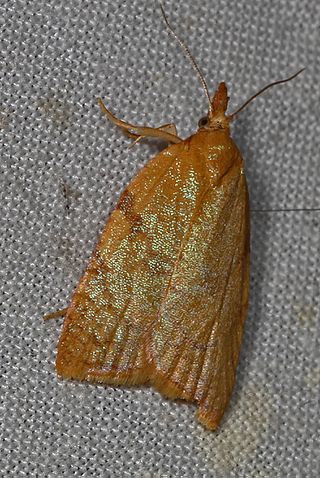
Sparganothis senecionana is a species of moth of the family Tortricidae. It is found in western North America, from British Columbia to Mexico and east to Colorado.
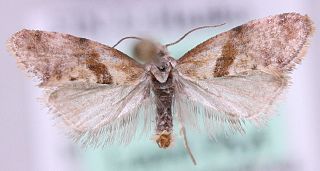
Cochylidia implicitana, the chamomile conch, is a moth of the family Tortricidae. It was described by Wocke in 1856. It is found in most of Europe, except Ireland and most of the Balkan Peninsula. Outside of Europe, it is found in Morocco, the Alatau mountains in Central Asia, Iran and China (Xinjiang). The habitat consists of waste ground and verges.

Cochylidia moguntiana is a species of moth of the family Tortricidae. It is found in Spain, Sweden, Denmark, Germany, Poland, Austria, Italy, the Czech Republic, Slovakia, Croatia, Hungary, Romania, Estonia, Latvia, Lithuania, Russia, Afghanistan, Kyrgyzstan, northern Pakistan, Iran, China and Korea.
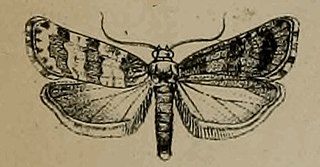
Cochylimorpha cultana is a species of moth of the family Tortricidae. It is found in China, Russia and Europe.

Cochylimorpha straminea, the straw conch, is a species of moth of the family Tortricidae. It is found in most of Europe, Morocco, Algeria, Tunisia, Asia Minor, the Palestinian territories, Iraq, Syria, Armenia, Transcaspia, Turkmenistan and Iran.

Choristoneura lafauryana, the strawberry leafroller, is a species of moth of the family Tortricidae. It is found in Spain, Great Britain, the Netherlands, Belgium, France, Germany, Switzerland, Italy, Romania and Russia. In the east, the range extends to China, Korea and Japan.

Thiodia torridana is a species of moth of the family Tortricidae. It is found in France, Germany, Austria, Switzerland, Italy, the Czech Republic, Slovakia, Slovenia, Hungary, Romania, Poland, Ukraine, Russia, Transcaucasia, Asia Minor, Kazakhstan, Turkmenistan and Kyrgyzstan.

Eucosma metzneriana, the mugwort bell, is a species of moth of the family Tortricidae. It is found on Sicily and in Great Britain, the Netherlands, Belgium, Luxembourg, France, Germany, Denmark, Austria, Switzerland, Italy, the Czech Republic, Slovakia, Slovenia, Hungary, Bulgaria, Romania, Poland, Sweden, Finland, the Baltic region, Ukraine, Russia, North Africa, Transcaucasia, Asia Minor, Iran, Kazakhstan, Kyrgyzstan, Mongolia, China, Korea and Japan.

Eucosma pupillana is a species of moth of the family Tortricidae.

Epiblema graphana is a species of moth of the family Tortricidae. It is found in Spain, France, Germany, the Benelux, Denmark, Austria, Switzerland, Italy, the Czech Republic, Slovakia, Poland, Norway, Sweden, Finland, the Baltic region, Albania, Romania, Bulgaria, Hungary, Slovenia, North Macedonia, Greece, the Near East, Russia, Kazakhstan, Iran, Afghanistan and China.

Eucosma agnatana is a species of moth of the family Tortricidae. It is found in China, Mongolia, Russia, Kazakhstan, Romania, Russia and the Near East.

Eucosma aspidiscana, the golden-rod bell, is a species of moth of the family Tortricidae. It is found in China, Mongolia, Korea, Japan, Russia, North Africa and most of Europe. The habitat consists of woodlands, downland, waste grounds and cliffs.
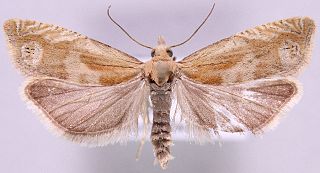
Eucosma hohenwartiana, the bright bell, is a species of moth of the family Tortricidae. It is found in China, Central Asia, North Africa and Europe, where it has been recorded from Sardinia, Sicily, Ireland, Great Britain, Spain, France, Germany, the Benelux, Denmark, Austria, Switzerland, Italy, the Czech Republic, Slovakia, Slovenia, Hungary, Poland, Romania, Bosnia and Herzegovina, Norway, Sweden, Finland, the Baltic region and Russia. The habitat consists of dry open areas and grassland.

Eucosma messingiana is a species of moth of the family Tortricidae. It is found in China, Mongolia, Russia and Europe, where it has been recorded from Germany, the Czech Republic, Denmark, Hungary, Poland, the Baltic region, Sweden and Finland. The habitat consists of sandy areas.
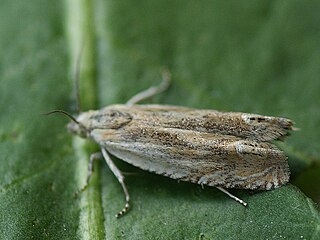
Eucosma wimmerana is a species of moth of the family Tortricidae. It is found in China, Mongolia, Japan, Russia, Kazakhstan and Europe, where it has been recorded from Sicily, France, the Netherlands, Germany, Austria, Switzerland, Italy, the Czech Republic, Slovakia, Poland, the Baltic region, Slovenia and Romania.

Pelochrista arabescana is a species of moth of the family Tortricidae. It is found in China, Mongolia, Iran, Kazakhstan and Europe, where it has been recorded from Hungary, Romania, Russia and Ukraine.

Acleris shepherdana, the meadow-sweet button, is a species of moth of the family Tortricidae. It is found in Europe, where it has been recorded from Great Britain, France, the Benelux, Germany, Denmark, Austria, Switzerland, Italy, the Czech Republic, Slovakia, Poland, Hungary, Norway, Sweden, Finland, the Baltic region and European Russia. It is also found in the Russian Far East (Ussuri), Manchuria, Mongolia, China and Japan. The habitat consists of fens, marshes, river-banks and other damp areas.





















